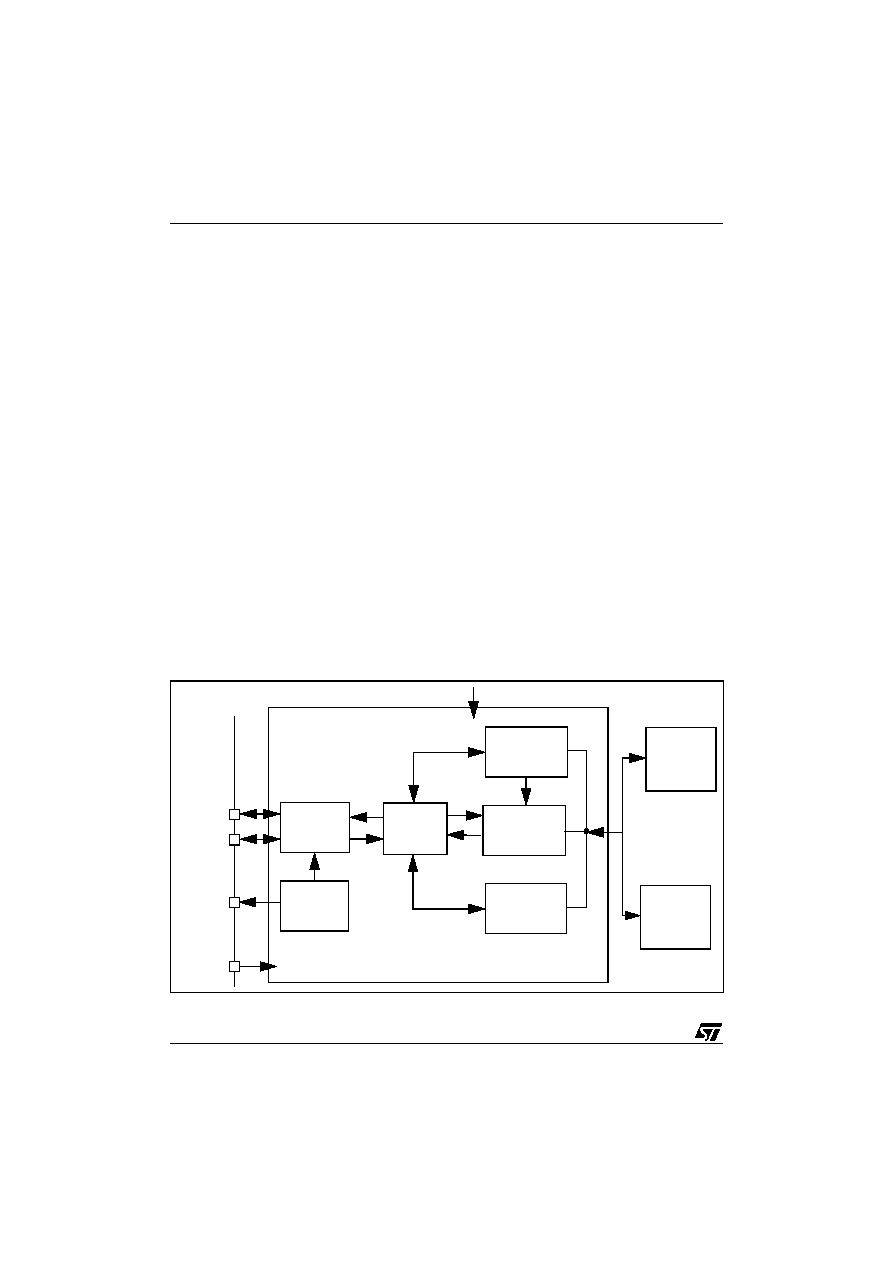- 您現(xiàn)在的位置:買賣IC網(wǎng) > PDF目錄98145 > ST72622K2B1 (STMICROELECTRONICS) 8-BIT, MROM, 8 MHz, MICROCONTROLLER, PQFP44 PDF資料下載
參數(shù)資料
| 型號: | ST72622K2B1 |
| 廠商: | STMICROELECTRONICS |
| 元件分類: | 微控制器/微處理器 |
| 英文描述: | 8-BIT, MROM, 8 MHz, MICROCONTROLLER, PQFP44 |
| 封裝: | TQFP-44 |
| 文件頁數(shù): | 118/136頁 |
| 文件大小: | 2475K |
| 代理商: | ST72622K2B1 |
第1頁第2頁第3頁第4頁第5頁第6頁第7頁第8頁第9頁第10頁第11頁第12頁第13頁第14頁第15頁第16頁第17頁第18頁第19頁第20頁第21頁第22頁第23頁第24頁第25頁第26頁第27頁第28頁第29頁第30頁第31頁第32頁第33頁第34頁第35頁第36頁第37頁第38頁第39頁第40頁第41頁第42頁第43頁第44頁第45頁第46頁第47頁第48頁第49頁第50頁第51頁第52頁第53頁第54頁第55頁第56頁第57頁第58頁第59頁第60頁第61頁第62頁第63頁第64頁第65頁第66頁第67頁第68頁第69頁第70頁第71頁第72頁第73頁第74頁第75頁第76頁第77頁第78頁第79頁第80頁第81頁第82頁第83頁第84頁第85頁第86頁第87頁第88頁第89頁第90頁第91頁第92頁第93頁第94頁第95頁第96頁第97頁第98頁第99頁第100頁第101頁第102頁第103頁第104頁第105頁第106頁第107頁第108頁第109頁第110頁第111頁第112頁第113頁第114頁第115頁第116頁第117頁當(dāng)前第118頁第119頁第120頁第121頁第122頁第123頁第124頁第125頁第126頁第127頁第128頁第129頁第130頁第131頁第132頁第133頁第134頁第135頁第136頁

ST7262
82/136
10.6 USB INTERFACE (USB)
10.6.1 Introduction
The USB Interface implements a low-speed func-
tion interface between the USB and the ST7 mi-
crocontroller. It is a highly integrated circuit which
includes the transceiver, 3.3 voltage regulator, SIE
and DMA. No external components are needed
apart from the external pull-up on USBDM for low
speed recognition by the USB host. The use of
DMA architecture allows the endpoint definition to
be completely flexible. Endpoints can be config-
ured by software as in or out.
10.6.2 Main Features
■ USB Specification Version 1.1 Compliant
■ Supports Low-Speed USB Protocol
■ Two or Three Endpoints (including default one)
depending on the device (see device feature list
and register map)
■ CRC
generation/checking,
NRZI
encoding/
decoding and bit-stuffing
■ USB Suspend/Resume operations
■ DMA Data transfers
■ On-Chip 3.3V Regulator
■ On-Chip USB Transceiver
10.6.3 Functional Description
The block diagram in Figure 50, gives an overview
of the USB interface hardware.
For general information on the USB, refer to the
“Universal Serial Bus Specifications” document
available at http//:www.usb.org.
Serial Interface Engine
The SIE (Serial Interface Engine) interfaces with
the USB, via the transceiver.
The SIE processes tokens, handles data transmis-
sion/reception, and handshaking as required by
the USB standard. It also performs frame format-
ting, including CRC generation and checking.
Endpoints
The Endpoint registers indicate if the microcontrol-
ler is ready to transmit/receive, and how many
bytes need to be transmitted.
DMA
When a token for a valid Endpoint is recognized by
the USB interface, the related data transfer takes
place, using DMA. At the end of the transaction, an
interrupt is generated.
Interrupts
By reading the Interrupt Status register, applica-
tion software can know which USB event has oc-
curred.
Figure 50. USB Block Diagram
CPU
MEMORY
Transceiver
3.3V
Voltage
Regulator
SIE
ENDPOINT
DMA
INTERRUPT
Address,
and interrupts
USBDM
USBDP
USBVCC
6 MHz
REGISTERS
data buses
USBGND
相關(guān)PDF資料 |
PDF描述 |
|---|---|
| ST72P621J4B1 | 8-BIT, MROM, 8 MHz, MICROCONTROLLER, PDIP32 |
| ST72P621J4T1 | 8-BIT, MROM, 8 MHz, MICROCONTROLLER, PDSO34 |
| ST72621J2B1 | 8-BIT, MROM, 8 MHz, MICROCONTROLLER, PDIP20 |
| ST72621J2T1 | 8-BIT, MROM, 8 MHz, MICROCONTROLLER, PDSO20 |
| ST72P621L4M1 | 8-BIT, MROM, 8 MHz, MICROCONTROLLER, PDSO34 |
相關(guān)代理商/技術(shù)參數(shù) |
參數(shù)描述 |
|---|---|
| ST7263-EMU2 | 功能描述:仿真器/模擬器 ST7 Emulator Board RoHS:否 制造商:Blackhawk 產(chǎn)品:System Trace Emulators 工具用于評估:C6000, C5000, C2000, OMAP, DAVINCI, SITARA, TMS470, TMS570, ARM 7/9, ARM Cortex A8/R4/M3 用于:XDS560v2 |
| ST7265X-EVAL/MS | 制造商:STMicroelectronics 功能描述:ST6 EVAL BD - Bulk |
| ST7265X-EVAL/PFD | 制造商:STMicroelectronics 功能描述:USB FLASH EVAL - Bulk |
| ST7266 | 制造商:6940 功能描述:ST7266 |
| ST7267C8T1L | 制造商:STMicroelectronics 功能描述: |
發(fā)布緊急采購,3分鐘左右您將得到回復(fù)。